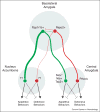Basolateral amygdala circuitry in positive and negative valence
- PMID: 29525574
- PMCID: PMC6138049
- DOI: 10.1016/j.conb.2018.02.012
Basolateral amygdala circuitry in positive and negative valence
Abstract
All organisms must solve the same fundamental problem: they must acquire rewards and avoid danger in order to survive. A key challenge for the nervous system is therefore to connect motivationally salient sensory stimuli to neural circuits that engage appropriate valence-specific behavioral responses. Anatomical, behavioral, and electrophysiological data have long suggested that the amygdala plays a central role in this process. Here we review experimental efforts leveraging recent technological advances to provide previously unattainable insights into the functional, anatomical, and genetic identity of neural populations within the amygdala that connect sensory stimuli to valence-specific behavioral responses.
Copyright © 2018 Elsevier Ltd. All rights reserved.
Conflict of interest statement
None of the authors have a conflict of interest.
Figures


References
-
- Brown S, Schafer E. An investigation into the functions of the occipital and temporal lobes of the monkey's brain. Philosophical Transactions of the Royal Society. 1888;179:303–327.
-
- Klüver H, Bucy P. 'Psychic blindness' and other symptoms following bilateral temporal lobectomy in Rhesus monkeys. American Journal of Physiology. 1937;119:352–353.
-
- Weiskrantz L. Behavioral changes associated with ablation of the amygdaloid complex in monkeys. J Comp Physiol Psychol. 1956;49(4):381–91. - PubMed
-
- Maren S. Neurobiology of Pavlovian fear conditioning. Annu Rev Neurosci. 2001;24:897–931. - PubMed
-
- Blanchard DC, Blanchard RJ. Innate and conditioned reactions to threat in rats with amygdaloid lesions. J Comp Physiol Psychol. 1972;81(2):281–90. - PubMed
Publication types
MeSH terms
Grants and funding
LinkOut - more resources
Full Text Sources
Other Literature Sources

